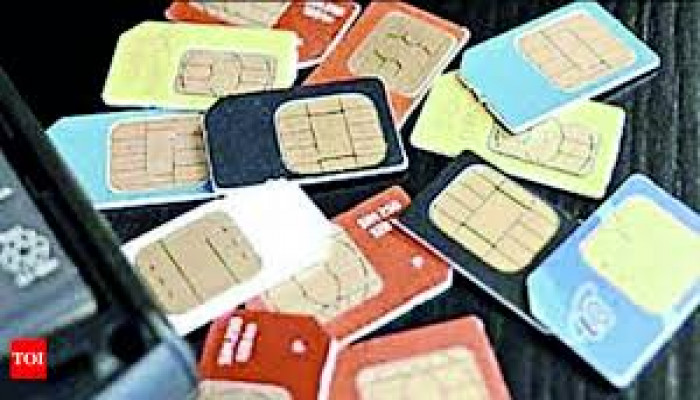Over 1 crore SIM cards blocked: Govt is throwing telecom scamsters out of range of users
- In Reports
- 08:23 PM, May 20, 2024
- Myind Staff
As of April 30, the telecom ministry has disconnected approximately 1.66 crore connections to combat fraud, officials reported. This move comes alongside a recent report indicating that telecom operators are set to disconnect around 18 lakh mobile connections nationwide due to fraudulent activities.
These actions are the result of a detailed investigation led by law enforcement agencies, including the Department of Telecommunications (DoT), and are part of the government’s broader strategy to secure the telecommunications landscape against financial scams in the country.
Fraudsters attempting to communicate with potential victims through calls, messages, or WhatsApp will find it increasingly difficult to succeed, as agencies have adopted a multi-tier approach. This strategy utilises several key platforms that not only aid citizens but also help agencies identify and track these scammers.
In May 2023, the Department of Telecommunications (DoT) launched a citizen-centric platform, Sanchar Saathi, aimed at enhancing the safety of mobile phone users. Since its launch, citizens have been using this portal to find out how many SIM cards have been issued in their names, identify specific numbers that may have been fraudulently obtained using their identities, and request authorities to block those numbers.
Sanchar Saathi data reveals that by mid-May 2024, over 16 lakh mobile phones were blocked and more than 8 lakh stolen or lost phones were traced. This initiative has helped authorities ensure that these mobile phones cannot be used for fraudulent activities.
Through the 'Know Your Mobile Connection (TAFCOP)' service on the Sanchar Saathi portal, citizens have submitted over seven lakh requests to the authorities. This service allows users to check the number of mobile connections registered in their names, making it easier to report connections that are either unnecessary or not used by the subscribers.
Building upon the success of Sanchar Saathi, C-DOT, the research wing of the telecom ministry, is developing the Sanchar Saathi app. This app aims to further strengthen the government’s efforts in addressing telecom-related fraud cases by providing a user-friendly interface for citizens to report and track fraudulent activities.
Additionally, in March 2024, the Department of Telecommunications (DoT) introduced Chakshu and the Digital Intelligence Platform (DIP) to enhance their endeavours in combating telecommunication-related cybercrime. These platforms have proven pivotal in identifying and addressing fraudulent activities involving mobile connections.
Chakshu plays a crucial role as a reporting tool for citizens to flag suspected fraudulent communications. It empowers users to report suspicious activities via calls, SMS, or WhatsApp, aiding in the detection and prevention of telecom resource misuse.
According to DoT officials speaking to News18, as of April 30 this year, around 1.58 lakh IMEI (International Mobile Equipment Identity) numbers associated with cybercrimes have been identified and blocked. By blocking these IMEI numbers, authorities have effectively rendered these handsets unable to access any telecommunication networks, thus preventing their use in further illegal activities. Additionally, approximately 10,000 to 11,000 mobile numbers have been earmarked for re-verification in Chakshu, and 52 Principal Entities (PEs) have been blocked due to suspicious activities.
The Digital Intelligence Platform (DIP) facilitates collaboration among stakeholders like the DoT, the Ministry of Home Affairs (MHA), and other relevant entities to combat telecom-related cybercrime and financial fraud. By consolidating resources and intelligence, DIP enhances the ability to identify and prevent telecom service misuse.
Recently, joint efforts by the DoT, MHA, and state police led to the resolution of telecom-related cyber fraud cases. Consequently, 28,200 mobile handsets were blocked, and re-verification of 20 lakh associated mobile connections was initiated.
The process involves cross-referencing mobile numbers provided by the MHA with existing databases to identify associated numbers. For instance, lost or stolen handsets with suspicious activity prompt a search for linked SIM cards, leading to the discovery of 20 lakh connections. Further steps include verifying SIM usage in other handsets, potentially uncovering more fraudulent activity. This proactive approach aids in identifying and blocking scam operations.
Recent enforcement actions highlight the effectiveness of these initiatives. In Varkala, Kerala, authorities arrested a shopkeeper for supplying 250 illegally arranged SIM cards to fraud groups. The investigation revealed a network involving Malayalees abroad, resulting in the seizure of 40,000 SIM cards and 180 mobile phones. Similarly, a recent raid in Rajasthan uncovered a significant network of illegal SIM card sellers, illustrating the widespread nature of the issue.
Regarding concerns about fraudulent messages on WhatsApp, DoT officials stated, "Whenever we receive information about such numbers, we share it with DIP stakeholders and WhatsApp. They then take action to permanently log them out from the messaging platform."
Besides these initiatives, the Telecom Regulatory Authority of India (TRAI) is developing the Calling Name Presentation (CNAP) system, similar to Truecaller. This system will display the caller’s name on the recipient's phone screen. Telecom ministry officials anticipate that this initiative will improve transparency and security in telecommunications, enabling users to identify legitimate calls and steer clear of potential scams.
Image Source: The Times of India







Comments